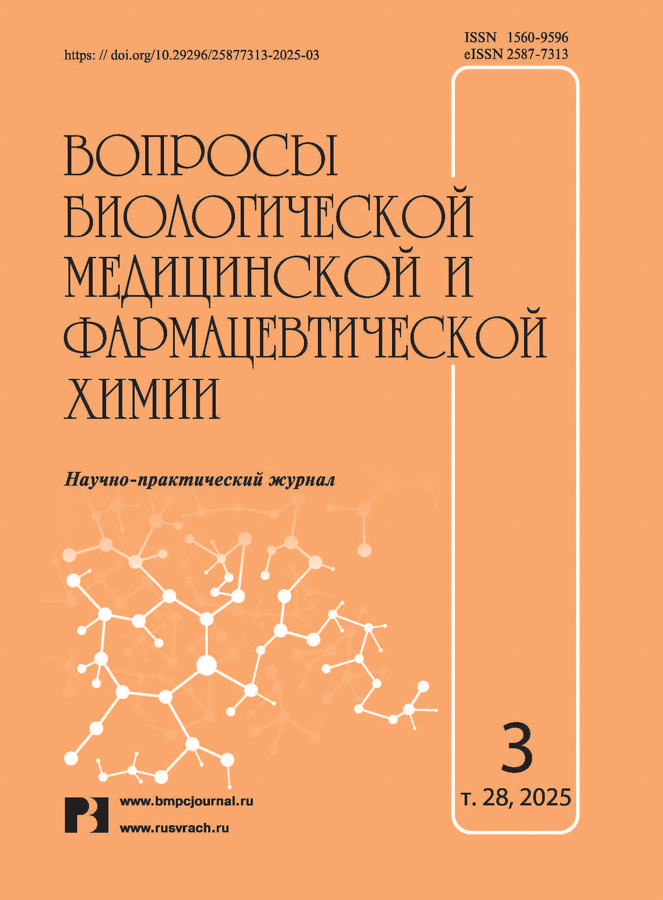Система контроля качества пробоподготовки и результатов анализа при диагностике вирусных гепатитов В и С методом ПЦР в реальном времени
- Авторы: Мороз А.С.1,2, Торопов В.А.2, Большаков В.Н.1,2, Аронова Е.Б.1
-
Учреждения:
- ФГАОУ ВО «Санкт-Петербургский политехнический университет Петра Великого»
- ГК «Алкор Био»
- Выпуск: Том 28, № 3 (2025)
- Страницы: 38-44
- Раздел: Биологическая химия
- URL: https://journals.eco-vector.com/1560-9596/article/view/677704
- DOI: https://doi.org/10.29296/25877313-2025-03-05
- ID: 677704
Цитировать
Полный текст
Аннотация
Введение. При проведении диагностических исследований на вирусоносительство критическое значение имеет предотвращение получения ложноотрицательных результатов. Для этого необходимо тщательно контролировать как все этапы процесса пробоподготовки, так и качество проведения самой диагностической реакции.
Цель работы – создание оптимального сочетания экзогенного контроля качества пробоподготовки и систем для детекции вирусов гепатитов В и С методом мультиплексной полимеразной цепной реакции (ПЦР) в реальном времени для улучшения точности, воспроизводимости и надежности результатов.
Материал и методы. Объект исследования – выделенная ДНК вируса гепатита B и РНК вируса гепатита C из образцов плазмы крови от пациентов с подтверждёнными диагнозами. Для выполнения исследования in silico использовали: онлайн-ресурс Primer-BLAST, интегрированный в базу данных NCBI; онлайн-сервис OligoAnalyzer Tool Oligo 7 (Integrated DNA Technologies), а также программы Oligo Primer Analysis Software, Clustal Omega и UGENE. Для проведения ПЦР в реальном времени прменяли амплификатор CFX96 Touch (Bio-Rad Laboratories, США). В ходе работы использовали набор для выделения нуклеиновых кислот МагноПлюс-НК-Био (ГК «Алкор Био», Россия). Процесс автоматического выделения проводили на станции Auto-Pure96 (Allsheng, Китай). ПЦР осуществляли с помощью наборов «Интифика ВГВ» и «Интифика ВГС» (ГК «Алкор Био», Россия).
Результаты. Разработана стабильная и устойчивая мультиплексная ПЦР-система для контроля качества пробоподготовки и диагностики вирусных гепатитов В и С при анализе плазмы крови человека. Показано, что использование термодинамического анализа при дизайне праймеров и зондов способствует повышению эффективности работы ПЦР-систем, а также повышает чувствительность и исключает ложноположительные результаты.
Выводы. Тщательная оптимизация характеристик праймеров и зондов при сочетании детекции экзогенного внутреннего контроля и вирусов в мультиплексной реакции значительно улучшает точность, воспроизводимость и надежность результатов анализа.
Полный текст
Об авторах
А. С. Мороз
ФГАОУ ВО «Санкт-Петербургский политехнический университет Петра Великого»; ГК «Алкор Био»
Автор, ответственный за переписку.
Email: anny-nice@mail.ru
ORCID iD: 0000-0002-4693-623X
SPIN-код: 4721-1020
аспирант, Высшая школа биотехнологий и пищевых производств; инженер-исследователь
Россия, 194021, Санкт-Петербург, ул. Новороссийская, 48; 192148, Санкт-Петербург, Железнодорожный пр., 40аВ. А. Торопов
ГК «Алкор Био»
Email: anny-nice@mail.ru
ORCID iD: 0009-0005-1993-5572
ведущий инженер-исследователь
Россия, 192148, Санкт-Петербург, Железнодорожный пр., 40аВ. Н. Большаков
ФГАОУ ВО «Санкт-Петербургский политехнический университет Петра Великого»; ГК «Алкор Био»
Email: anny-nice@mail.ru
ORCID iD: 0009-0007-5126-6035
к.б.н., доцент, доцент Высшей школы биотехнологий и пищевых производств; руководитель лаборатории молекулярной диагностики
Россия, 194021, Санкт-Петербург, ул. Новороссийская, 48; 192148, Санкт-Петербург, Железнодорожный пр., 40аЕ. Б. Аронова
ФГАОУ ВО «Санкт-Петербургский политехнический университет Петра Великого»
Email: anny-nice@mail.ru
ORCID iD: 0000-0003-4376-2972
SPIN-код: 7288-6820
к.т.н., доцент, доцент Высшей школы биотехнологий и пищевых производств
Россия, 194021, Санкт-Петербург, ул. Новороссийская, 48Список литературы
- Фаенко А.П., Филиппова А.А., Голосова С.А. и др. Внедрение лабораторного исследования на анти-НВсоге у доноров крови. Гематология и трансфузиология. 2022; 67(4): 525–534. [Faenko A.P., Filippova A.A., Golosova S.A. i dr. The introduction of Laboratory testing for anti-HBcore in blood donors. Gematologiya i transfuziologiya. 2022; 67(4): 525–534. (In Russ.)]. doi: 10.35754/0234-5730-2022-67-4-525-534.
- Останкова Ю.В., Серикова Е.Н., Семенов А.В. и др. Молекулярно-генетическая характеристика полнораз-мерного генома вируса гепатита В у HBsAg-негативных доноров крови в Уральском федеральном округе. Журнал микробиологии, эпидемиологии и иммунобиологии. 2022; 99(6): 637–650. [Ostankova Yu.V., Serikova E.N., Semenov A.V. i dr. Molecular and genetic characterization of the hepatitis B virus full-length genome sequences identified in HBsAg-negative blood donors in Ural Federal District. Zhurnal mikrobiologii, epidemiologii i immunobiologii. 2022; 99(6): 637–650. (In Russ.)]. DOI: https://doi.org/10.36233/0372-9311-325.
- Хорькова Е.В., Лялина Л.В., Микаилова О.М. и др. Актуальные вопросы эпидемиологического надзора за хроническими вирусными гепатитами B, C, D и гепатоцеллюлярной карциномой на региональном уровне. Здоровье населения и среда обитания. 2021;29(8):76-84. [Khorkova E.V., Lyalina L.V., Mikailova O.M. i dr. Current issues of epidemiological surveillance of chronic viral hepatitis B, C, D and hepatocellular carcinoma at the regional level. Zdorov'e naseleniya i sreda obitaniya. 2021;29(8):76-84. (In Russ.)]. doi: 10.35627/2219-5238/2021-29-8-76-84.
- Волков А.Н., Начева Л.В. Молекулярно-генетические методы в практике современных медико-биологических исследований. ЧАСТЬ III: генодиагностика человека при решении медицинских задач. Фундаментальная и клиническая медицина. 2021; 6(3): 100–109. [Volkov A.N., Nacheva L.V. Molecular genetic methods in biomedical research. Part III: human gene diagnostics in clinical practice. Fundamental'naya i klinicheskaya meditsina. 2021; 6(3): 100–109. (In Russ.)]. doi: 10.23946/2500-0764-2021-6-3-100-109.
- Aydogan S., Acikgoz Z.C, Gozalan A. et al. Comparison of a novel real-time PCR method (RTA) and Artus RG for the quantification of HBV DNA and HCV RNA. J Infect Dev Ctries. 2017; 11(7): 543–548. doi: 10.3855/jidc.8363.
- Tan B., Qin L., Chen C. et al. Multiplex fluorescence quantitative polymerase chain reaction for simultaneous detection of hepatitis B virus, hepatitis C virus and human immunodeficiency virus. Clin Lab. 2015; 61(1-2): 53–59. doi: 10.7754/clin.lab.2014.131102.
- Оскорбин И.П., Шевелёв Г.Ю., Проняева К.А. и др. Вы-явление РНК SARS-CoV2 с помощью мультиплексной изо-термической петлевой амплификации с обратной транс-крипцией методом анализа кривых плавления. Вопросы биологической, медицинской и фармацевтичес-кой химии. 2020; 23(12): 3−10. [Oscorbin I.P., Shevelev G.Yu., Pronyaeva K.A. i dr. Detection of SARS-CoV2 RNA using multiplex reverse transcription loop-mediated isothermal amplification with melting curve analysis. Voprosy biologicheskoi, meditsinskoi i farmatsevticheskoi khimii. 2020; 23(12): 3–10. (In Russ.)]. doi: 10.29296/25877313-2020-12-01.
- Da Silva M.C.C., De Abreu L.C.L., Do Carmo F.A. et al. Development of a validation protocol method for nucleic acid testing to detect human immunodeficiency virus, hepatitis C virus, and hepatitis B virus. An Acad Bras Cienc. 2022; 94(3). doi: 10.1590/0001-3765202220211321.
- Martínez-Santolaria M., Sota-Diez C., García-Manrique B. et al. A-300 Evaluation of Different Storage Conditions of Nasopharyngeal Swabs for the Detection of Influenza A, Influenza B and RSV. Clinical Chemistry. 2023; 69(1). doi: 10.1093/clinchem/hvad097.265.
- Cheung H.W., Wong K.S., Lin V.Y.C. et al. Optimization and implementation of four duplex quantitative polymerase chain reaction assays for gene doping control in horseracing. Drug Test Anal. 2022; 14(9): 1587–1598. doi: 10.1002/dta.3328.
Дополнительные файлы










